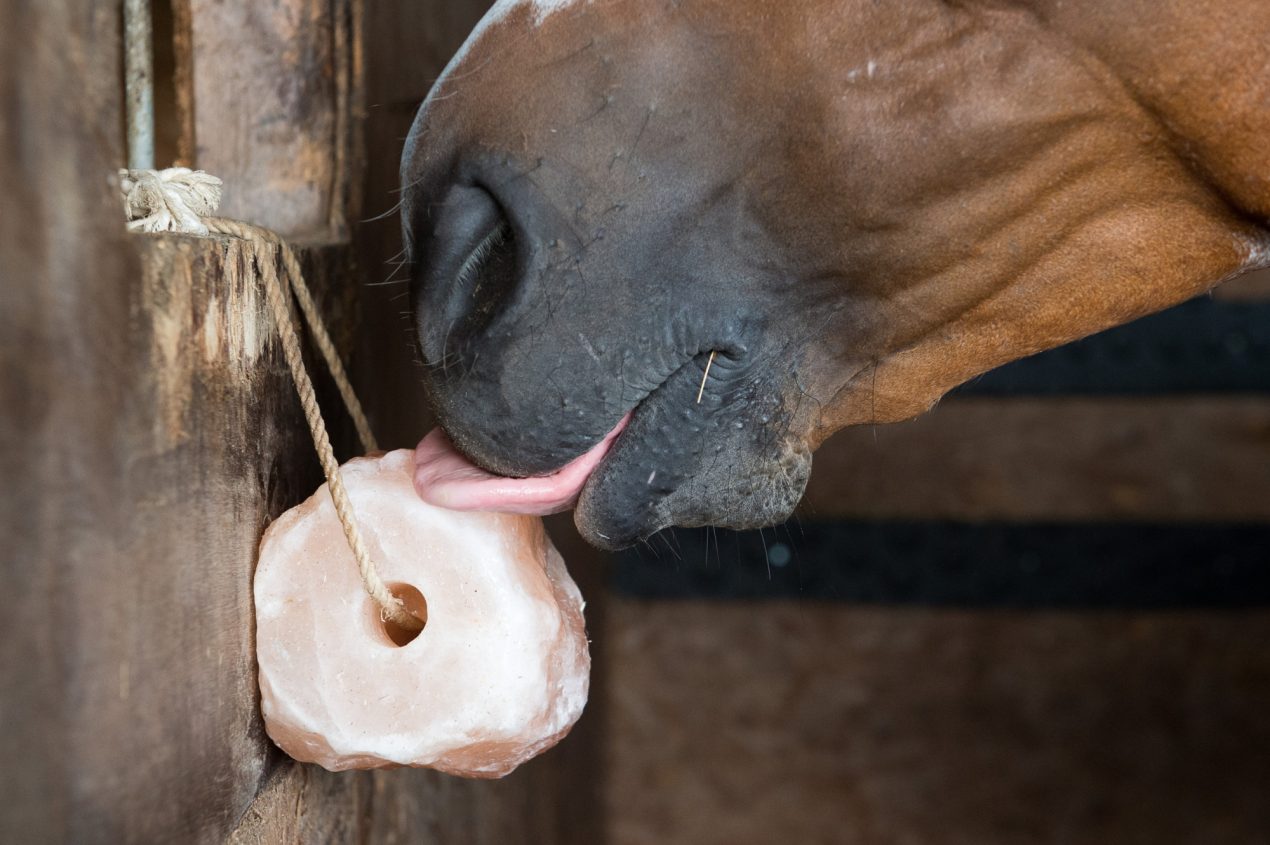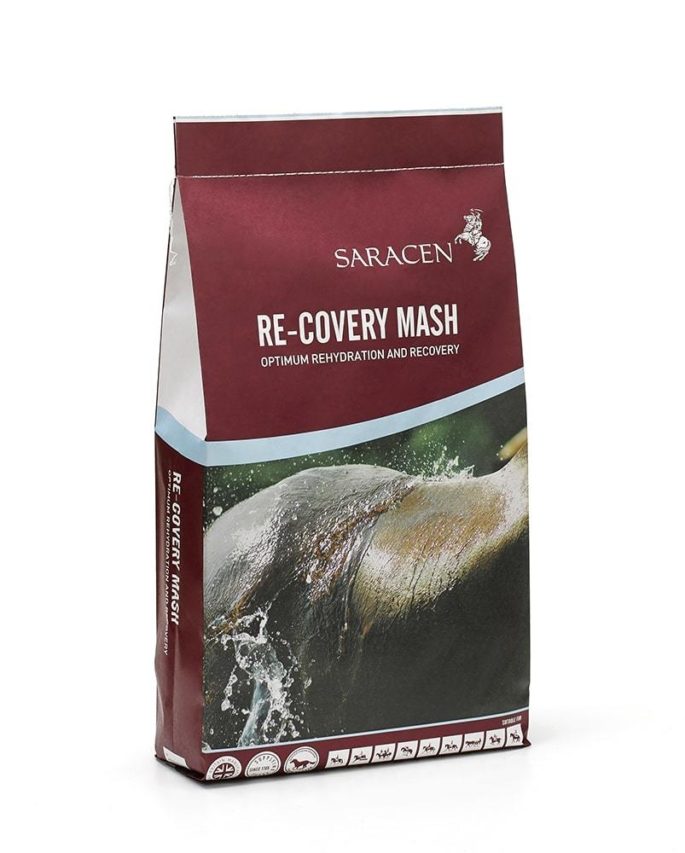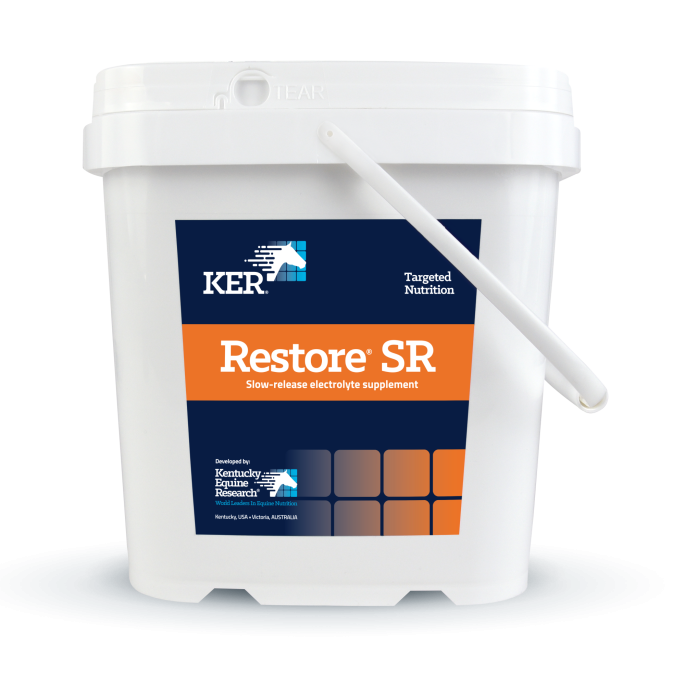Understanding Electrolytes

Electrolytes are minerals (Na, K, Cl) which dissociate into ions in solutions with electrical charges in the plasma to maintain osmolarity of the plasma and fluid balance. Body fluids and the electrolytes sodium (Na), potassium (K) and chloride (Cl) hold a key position in the thermoregulation of sweating animals. The osmotic concentration (osmolality) of body fluids is important in preventing cell dehydration or cell swelling by controlling fluid shifts, as well as controlling thirst and drinking. The correct balance of body fluids is essential for optimal health and athletic performance and is maintained by the intake and loss of electrolytes and the movement between the fluids at cellular level.
To maintain hydration in a horse, it is vital that horses have access to water; electrolytes should not be replenished after exercise without the horses drinking water. Horses will drink between 15 – 60 L of water / day and will drink more if their diet is high in potassium and protein. Water accounts for 60 – 70% of body weight in the adult, 70 -80% in foals, with 65-70% being in intracellular fluid (ICF) and the remainder in extracellular fluid (ECF).
The amount of water and electrolytes lost in sweat is independent of diet and is only affected by workload and weather. Fluid requirement is dramatically increased by work (increasing in accordance with the severity of the work) and by increased loss in sweat and from the respiratory tract
Inadequate intake or excessive loss of fluid or electrolytes results in disorders of fluid balance. Rises in environmental temperature increases water requirement so that a rise from 15 degrees C to 20 degrees C increased the requirement by 15-20%.
DIETARY REPLACEMENT OF ELECTROLYTES
Homeostasis can be helped in the competing horse by supplementation with water and electrolytes before, during and after work to counteract depletion and optimise performance. Unlike carbohydrate loading in the human athlete, it is not possible to pre-load with electrolytes, but merely to correct any existing deficits. Where electrolyte losses are expected and it is important that electrolyte levels are optimised in preparation, tapering of the work load for two to three days in advance may help this.
Some of the electrolyte requirements are obtained from natural food sources, but in the working horse these will usually need to be supplemented. Principal natural sources of electrolytes are:
• Ca : leafy forages, particularly legumes
• P – cereal grains and by-products
• Mg – legume forages, sugar beet pulp, sugar beet molasses
• K – leafy forages, sugar beet molasses and milk products
• Na and CL – common salt, milk products, sugar beet molasses
Electrolyte levels in compound feeds
All compound feeds and forage sources contain electrolytes; however, these sources are generally only enough for horses in light work or at pasture and most will be deficient in sodium. Sodium attracts water and high levels of sodium in commercially available feeds would lead to an increase in spoilage which is why sodium may be deficient in feed. There will also be differences between commercially prepared feeds to what electrolytes are provided by the feed and in what quantities depending on the brand that you buy. This is also true of forage as many factors (including where the forage was grown, the soil quality and water condition during growing) will affect the electrolyte levels. Pasture and forage are generally high in potassium and can provide adequate levels of magnesium, however chloride levels are variable, and sodium tends to be low. Cereals are also deficient in electrolytes, and cereal rich or cereal only diets are commonly electrolyte deficient and additional supplementation would need to be sought.
When choosing an electrolyte supplement be sure to not only look at the percentage electrolyte inclusion but also the feeding rate. Although two supplements may appear to provide the same or similar level of electrolyte supplementation, one may have a higher feeding rate and will therefore provide a higher level of electrolytes. It’s also important to ensure that the electrolyte supplement you are feeding does not contain high levels of sugar (usually seen as dextrose on the label). If your supplement does not taste like salt, it is unlikely to replace your horse’s electrolyte losses.
Oral Supplementation
Powders The easiest method of providing electrolyte supplementation is by feeding salts as a powder mixed into feed. The composition can become increasingly complex depending on the quantity of work required. Forage contains low levels of sodium and chloride so that the working horse will require at least supplementation of these. The most basic supplement, NaCl, common salt should be added at approximately 50g daily. The provision of salt licks is inadequate; the horse will not lick the amount necessary to fulfil its requirements. The amount taken will depend on the palatability of block, depending on the other constituents.
Solutions Hypotonic and isotonic fluids are absorbed more rapidly than hypertonic fluids and fluid and electrolyte excretion in urine is slower. Isotonic fluid intake is ideal. Isotonic fluids are not very palatable, and so horses should be trained to drink balanced electrolytes in solution. This may start with a very dilute solution and electrolyte concentration can increase as the horse becomes accustomed to drinking the solution. The addition of flavourings may help to disguise the flavour of the electrolytes. Apple juice or peppermint essence can be useful for this. The addition of water in which sugar beet pulp has been soaked is also a practical alternative and, in addition, provides extra supplementation of calcium.
Pastes Although it is unlikely that hypertonic fluids in water would be given, hypertonic pastes can be a practical method of replacing electrolytes where a horse will not drink electrolytes in water voluntarily. Hypertonic fluids draw water into the intestinal lumen until the solution is isotonic, thus dehydrating the horse further. This will also increase the horse’s thirst so that an unrestricted supply of water should be available at the same time.Electrolyte preparations in the small intestine must become isotonic before they can be absorbed so the absorption of hypertonic preparations may be delayed.
Note : Concentrated pastes may come into contact with gastric ulcers in the stomach and cause a painful response like putting salt on an open wound, so that colic signs may be evident. If it is intended to use concentrated electrolyte pastes, then the likelihood of the presence of gastric ulcers should be considered.

REACH FOR RE-COVERY™
Saracen Horse Feeds RE-COVERY Mash™ has been formulated to tick both boxes with regards to a way of increasing water intake as well as stimulating the thirst response. Formulated on a blend of ’Super-Fibres’, known for their superior digestibility and provision of non-heating calories, the banana flavoured RE-COVERY Mash™ can be fed as and when needed, alongside any diet because no vitamins or minerals have been added. Drenched in water, ideally with water sitting on top of the feed, the horse is encouraged to drink the fluid before eating the mash which includes a source of electrolytes to help stimulate the thirst response after exertion, training and travelling as well as during the change of season. Saracen RE-COVERY Mash™ will take 2-3 minutes to soak in warm water or 5 minutes in cold water and should be fed immediately, ideally before travelling home after competing.

Restore SR contains the latest technology in electrolyte research, including a proprietary slow-release mechanism that allows sodium to be released gradually into the gastrointestinal tract for sustained absorption. When sodium is delivered slowly over a period of time, it is fully absorbed and utilised by the body. This is not always the case with the normal method of feeding a concentrated electrolyte dose, which causes a surge in blood electrolyte levels, and stimulates increased excretion of electrolytes, flushing out the electrolytes that have just been fed. Restore SR helps horses to retain the electrolytes provided so they can replenish their reserves in the most optimal manner—slowly.
NEED HELP?
If you require immediate advice, please call our dedicated nutritional team on the number below to speak to a qualified nutritionist.
T: 01622 718487
Feed Advice Form
Complete our online form to receive a detailed nutritional plan for your horse or pony from one of our registered nutritionists.
Equinews
Stay up-to-date with the latest version of Equinews, a digital newsletter from Kentucky Equine Research











